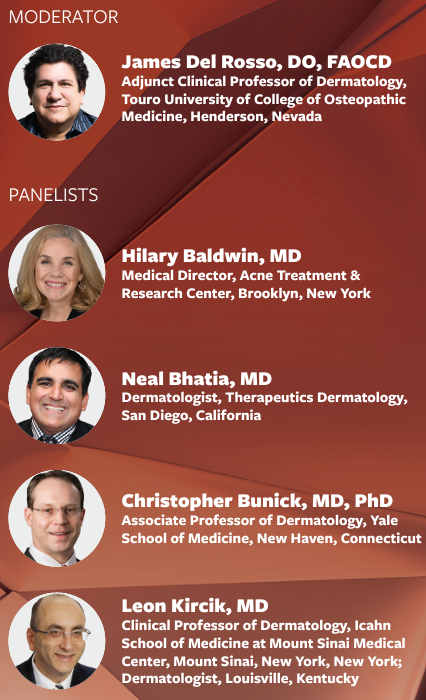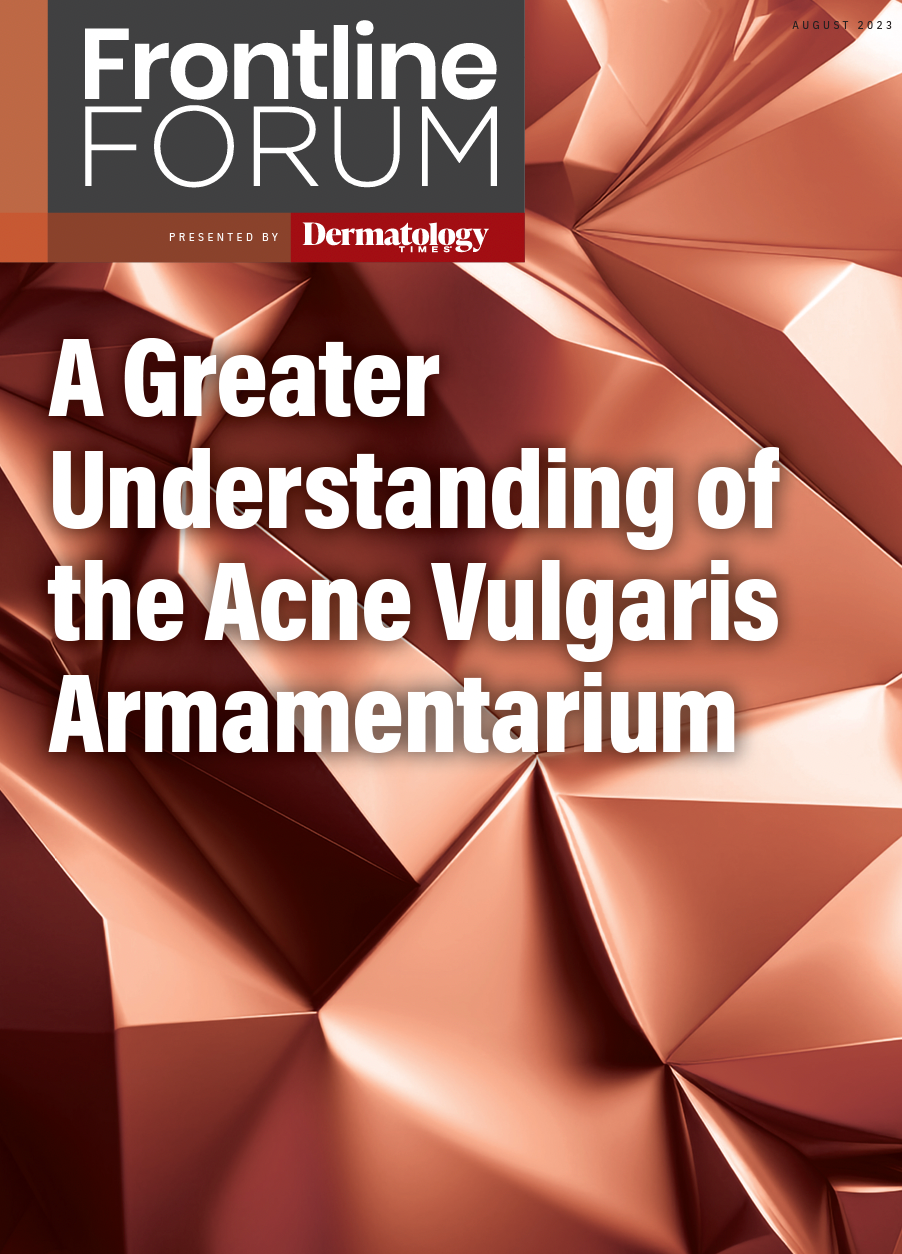- Case-Based Roundtable
- General Dermatology
- Eczema
- Chronic Hand Eczema
- Alopecia
- Aesthetics
- Vitiligo
- COVID-19
- Actinic Keratosis
- Precision Medicine and Biologics
- Rare Disease
- Wound Care
- Rosacea
- Psoriasis
- Psoriatic Arthritis
- Atopic Dermatitis
- Melasma
- NP and PA
- Skin Cancer
- Hidradenitis Suppurativa
- Drug Watch
- Pigmentary Disorders
- Acne
- Pediatric Dermatology
- Practice Management
- Prurigo Nodularis
- Buy-and-Bill
Publication
Article
Dermatology Times
Frontline Forum Part 1: A Greater Understanding of the Acne Vulgaris Armamentarium
Author(s):
In part 1 of this Frontline Forum series, James Del Rosso, DO; Hilary Baldwin, MD; Neal Bhatia, MD; Christopher Bunick, MD, PhD; and Leon Kircik, MD, discuss the pathogenesis of acne vulgaris, the use of clascoterone cream 1%, differences in isotretinoin formulations, targeting sebum production, acne guidelines for patient care, and more.

Affecting approximately 50 million people in the United States and up to 85% of teenagers, acne vulgaris (AV) can result in physical and psychologic effects such as permanent scarring, poor self-image, depression, and anxiety and continues to be an issue for patients presenting to dermatologists.1 In a recent Frontline Forum series titled “Expert Perspectives on the Management of Acne Vulgaris,” panelists discussed their strategies for evaluation and management of patients with AV, potential roles for topical treatment in the AV treatment landscape, and clinical implications of the newer isotretinoin formulations.
Overview of Acne Vulgarisand Factors Leading to Diagnosis
Although the pathogenesis of acne is not fully understood, the 4 main factors thought to contribute include follicular hyperkeratinization, microbial colonization with Cutibacterium acnes (C acnes), production of sebum, and complex inflammatory mechanisms, with interleukin-1 (IL-1), tumor necrosis factor, IL-8, and IL-12 cited as notable cytokines involved in the development of acne lesions and inflammatory response.1 The C acnes is also thought to trigger inflammatory reactions in the pilosebaceous units and adjacent areas of the skin through interactions with keratinocytes, sebocytes, and tissue macrophages in the skin.2
The increase in sebum production and high incidence of acne around puberty suggest that hormonal changes likely play a key role, and these may originate well before puberty, according to the panelists. A 5-year longitudinal cohort study of prepubertal girls found that, compared with those who developed mild or moderate acne, patients who later developed severe acne had higher levels of serum dehydroepiandrosterone sulfate and testosterone and a greater number of comedones and inflammatory lesions beginning as early as 3 years prior to menarche.3 Neuroendocrine mechanisms, diet, and genetic factors have also been implicated in AV pathogenesis, and Del Rosso said that family history of severe acne is a notable risk factor for development of AV in his clinical experience.
A big misperception about AV among patients is that it stems from a lack of cleanliness, said Bunick. “Patients come in, and they’re [upset:] ‘Doctor, I’ve been washing my face 3 times a day; I’m using all these over-the-counter-products.’ They try to wash their acne away because they’re told or taught, or the misperception is out there in the community, that you’re dirty if you have acne.”
Bunick estimated that the number of office visits for acne is approximately 3 times higher among women compared with men in individuals aged 20 to 50 years. However, the notion that acne only has a hormonal component in female patients is another misconception that is important to dispel among patients and practitioners, according to the panelists. “[There is] the mind-set that you only have to address hormones in female [patients], which certainly is not correct because what we’re talking about doesn’t discriminate between [men and women],” said Del Rosso.
Multiple tools have been developed for assessment of acne and may include the type, severity, number, location, and extent of acne lesions, as well as psychosocial measures and scarring.1 However, there is no consensus on the best tool to use, and the interobserver reliability can be low with some grading systems.1 The panelists said that they assess the number and morphology of the lesions, presence of lesions on the back, potential psychologic issues, and presence of scarring, which “raises the bar of the severity significantly” regardless of the number of lesions, according to Del Rosso.
Once AV is diagnosed, there are multiple treatment options to pursue.
Developing a Treatment Plan for AV Patients
For mild AV, the clinical practice guidelines from the American Academy of Dermatology recommend first-line treatment with benzoyl peroxide (BP), topical retinoid, or topical combination therapy (BP plus an antibiotic and/or retinoid); alternative strategies listed include addition of a topical retinoid or BP, use of a different retinoid, or addition of oral dapsone.1 For moderate AV, first-line treatment options include topical combination therapy comprising of BP plus a retinoid and/or a topical antibiotic; oral antibiotic plus BP and topical retinoid; or oral and topical antibiotics, BP, and a topical retinoid.1 For severe disease, first-line treatment options include an oral antibiotic plus topical combination therapy or oral isotretinoin.1 Adding combined oral contraceptives or spironolactone may be considered as an alternative treatment option for female patients with moderate or severe disease.1
Although accelerating the healing process of existing lesions is important, the panelists said that the primary purpose of AV treatment is to prevent development of new lesions. Bunick added that many dermatologists and patients mistakenly focus solely on spot treatment, which is not sufficient for long-term resolution. “You’re treating today for next month’s acne,” said Baldwin. Bunick added that management of AV is often approached reactively rather than proactively, and identification of biomarkers to predict development of acne and scarring would be helpful to “get ahead of the acne scarring curve.”
Disclosure
This Frontline Forum is supported by Sun Pharmaceutical Industries Ltd.
References
1. Zaenglein AL, Pathy AL, Schlosser BJ, et al. Guidelines of care for the management of acne vulgaris (published correction appears in J Am Acad Dermatol. 2020 Jun;82(6):1576. J Am Acad Dermatol. 2016;74(5):945-973.e33. doi:10.1016/j.jaad.2015.12.037
2. Firlej E, Kowalska W, Szymaszek K, Roliński J, Bartosińska J. The role of skin immune system in acne. J Clin Med. 2022;11(6):1579. doi:10.3390/jcm11061579
3. Lucky AW, Biro FM, Simbartl LA, Morrison JA, Sorg NW. Predictors of severity of acne vulgaris in young adolescent girls: results of a five-year longitudinal study. J Pediatr. 1997;130(1):30-39. doi:10.1016/s0022-3476(97)70307-x






